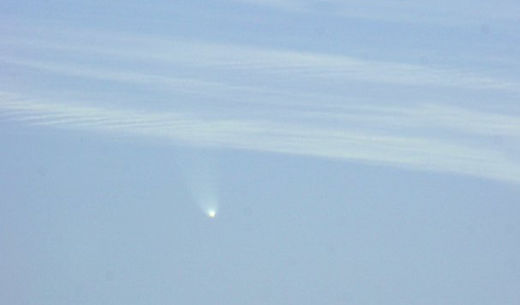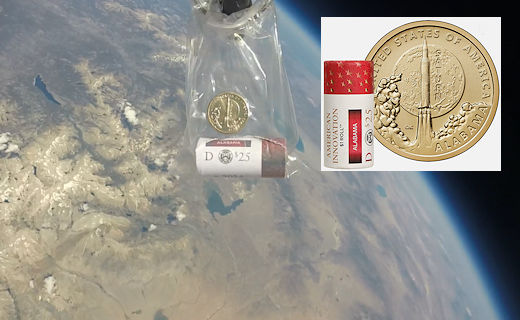This is an AI Free Zone! Text created by Large Language Models is spreading rapidly across the Internet. It's well-written, artificial, frequently inaccurate. If you find a mistake on Spaceweather.com, rest assured it was made by a real human being. | | |
GEOMAGNETIC STORM WATCH (G1): Two and possibly three faint CMEs are heading for Earth following a series of eruptions from sunspots AR3743, AR3753, and AR3744 on July 16-17. Their collective impact on July 20-21 could cause a minor G1-class geomagnetic storm. Aurora alerts: SMS Text
INCOMING 'DAYLIGHT COMET' MIGHT NOT FALL APART: Comet Tsuchinshan-ATLAS (C/2023 A3) might not be falling apart, after all. Last week, respected researcher Zdenek Sekanina suggested that the comet's destruction was inevitable and, indeed, already underway. New data, however, give hope that it could survive for a daylight apparition later this year.

Above: Comet Tsuchinshan-ATLAS photographed on July 13 by Eliot Herman using a telescope in Chile
Astronomers using the TRAPPIST telescopes in Chile recently measured the comet's water production rate. They found a healthy 2x1028 molecules/s emerging from the nucleus. "That is about the rate expected for a ~100% active nucleus of ~2 km diameter," notes comet expert Qicheng Zhang of the Lowell Observatory. "A comet of that size shouldn't be disintegrating at its current distance from the sun (1.6 au)."
Indeed, it appears to be intact. If the comet's nucleus had split into a swarm of boulders, the comet's coma (its atmosphere) would look like a superposition of "comets within comets." Instead, it has the parabolic windsock shape of a single large nucleus falling into the sun. "A field of active boulders cannot physically produce the coma we see right now," says Zhang.
For a while, astronomers worried about the comet's light curve, which temporarily faded earlier this year:

Above: The comet's light curve, courtesy Nick James of the BAA.
"Now, however, it is brightening quite rapidly and the lightcurve is smooth with no indication of any fragmentation or outbursts," reports Nick James, director of the Comet Section of the British Astronomical Association (BAA).
All of this is potentially good news for sky watchers. If Tsuchinshan-ATLAS can hold itself together for a few more months, it could put on quite a show.
"If the comet continues to behave as it is now, it will brighten to magnitude +4 ± 1 at perihelion on Sept. 27th, to a daylight peak of -3 ± 1 near inferior conjunction on Oct. 9th, and subsequently produce a quite possibly 20+ degree dust tail visible under dark skies (Oct ~19) before fading away," says Zhang.

Comet McNaught photographed in daylight by Thorsten Boeckel on Jan. 13, 2007. [gallery]
The potential daylight visibility in October depends in part on a process called "forward scattering." Forward scattering happens when a comet passes almost directly between Earth and the sun. Dust in the comet's atmosphere can scatter sunlight toward Earth, making the comet seem extra bright. The same thing happened to Comet McNaught in 2007, making it visible in broad daylight as a magnitude -5.5 object.
Nick James expects the comet to brighten "quite rapidly" during the next month, and he encourages observers in the southern hemisphere (where the comet is currently visible) to monitor developments. Stay tuned!
Realtime Comet Photo Gallery
Free: Spaceweather.com Newsletter
REAL MONEY FROM SPACE: On July 16, 1969, the world watched as a Saturn V rocket launched Neil Armstrong, Buzz Aldrin, and Michael Collins to the Moon. Exactly 55 years later, the students of Earth to Sky Calculus launched the US Mint's limited edition Saturn V dollar coin to the stratosphere:

You can have a single coin for $49.95 or an entire unbroken roll for $249.95. No longer available from the US Mint, these rare coins flew 121,665 feet above the Sierra Nevada on July 16, 2024. One side shows the mighty Saturn V rocket blasting off from Cape Canaveral; the other side features the Statue of Liberty in profile.
The students are selling space coins to support to support their cosmic ray research program. (Helium is expensive!) Each order comes with a greeting card showing the coins in flight and telling the story of their journey to the stratosphere and back again.
Far Out Gifts: Earth to Sky Store
All sales support hands-on STEM education
Realtime Aurora Photo Gallery
Free: Spaceweather.com Newsletter
Realtime Space Weather Photo Gallery
Free: Spaceweather.com Newsletter
Realtime Noctilucent Cloud Photo Gallery
Free: Spaceweather.com Newsletter
Every night, a network of
NASA all-sky cameras scans the skies above the United States for meteoritic fireballs. Automated software maintained by NASA's Meteoroid Environment Office calculates their orbits, velocity, penetration depth in Earth's atmosphere and many other characteristics. Daily results are presented here on Spaceweather.com.
On Jul 20, 2024, the network reported 9 fireballs.
(9 sporadics)

In this diagram of the inner solar system, all of the fireball orbits intersect at a single point--Earth. The orbits are color-coded by velocity, from slow (red) to fast (blue). [Larger image] [movies]
Potentially Hazardous Asteroids (
PHAs) are space rocks larger than approximately 100m that can come closer to Earth than 0.05 AU. None of the known PHAs is on a collision course with our planet, although astronomers are finding
new ones all the time.
On July 20, 2024 there were 2349 potentially hazardous asteroids.
 |
Recent & Upcoming Earth-asteroid encounters: | Asteroid | Date(UT) | Miss Distance | Velocity (km/s) | Diameter (m) |
| 2024 BY15 | 2024-Jul-16 | 16.2 LD | 0.7 | 16 |
| 2024 NJ3 | 2024-Jul-17 | 3.2 LD | 6.4 | 15 |
| 2024 NF | 2024-Jul-17 | 12.6 LD | 20.3 | 70 |
| 2024 NM3 | 2024-Jul-17 | 2 LD | 7.4 | 32 |
| 2024 MG1 | 2024-Jul-21 | 11.1 LD | 9.3 | 57 |
| 2024 NH | 2024-Jul-23 | 13.1 LD | 5.5 | 29 |
| 2024 LY2 | 2024-Jul-23 | 12 LD | 7.8 | 92 |
| 2011 MW1 | 2024-Jul-25 | 10.1 LD | 8 | 120 |
| 2024 NV1 | 2024-Jul-25 | 14.1 LD | 10.2 | 32 |
| 2024 MH1 | 2024-Jul-26 | 4.7 LD | 5.8 | 29 |
| 2011 AM24 | 2024-Jul-26 | 16.8 LD | 6.2 | 281 |
| 2024 NZ1 | 2024-Jul-28 | 19.5 LD | 12.8 | 57 |
| 523664 | 2024-Jul-28 | 14.9 LD | 23.7 | 680 |
| 2024 NS1 | 2024-Aug-02 | 5.3 LD | 7.6 | 51 |
| 2020 PN1 | 2024-Aug-02 | 18 LD | 5.5 | 29 |
| 2023 HB7 | 2024-Aug-05 | 14.7 LD | 6.1 | 32 |
| 2017 TU1 | 2024-Aug-05 | 10.1 LD | 10.1 | 22 |
| 2024 KH3 | 2024-Aug-10 | 14.6 LD | 11.4 | 192 |
| 2021 GY1 | 2024-Aug-16 | 17.7 LD | 6.3 | 59 |
| 2024 JV33 | 2024-Aug-19 | 12 LD | 11.1 | 207 |
| 2022 BF2 | 2024-Aug-19 | 19.7 LD | 16.4 | 91 |
| 2020 RL | 2024-Aug-27 | 12.2 LD | 8.2 | 34 |
| 2021 RA10 | 2024-Aug-28 | 6.8 LD | 4.9 | 29 |
| 2012 SX49 | 2024-Aug-29 | 11.2 LD | 4.3 | 20 |
| 2016 RJ20 | 2024-Aug-30 | 18.3 LD | 14.8 | 68 |
| 2021 JT | 2024-Sep-01 | 16.4 LD | 8.2 | 12 |
| 2021 RB16 | 2024-Sep-02 | 12.3 LD | 8.4 | 15 |
| 2007 RX8 | 2024-Sep-02 | 18.5 LD | 7 | 44 |
| 2022 SR | 2024-Sep-07 | 9.1 LD | 6.3 | 42 |
| 2023 SP2 | 2024-Sep-09 | 15.3 LD | 4.2 | 8 |
| 2016 TU19 | 2024-Sep-11 | 13.2 LD | 10.1 | 47 |
| 2019 DJ1 | 2024-Sep-15 | 10.4 LD | 4.9 | 15 |
Notes: LD means "Lunar Distance." 1 LD = 384,401 km, the distance between Earth and the Moon. 1 LD also equals 0.00256 AU. | | Cosmic Rays in the Atmosphere |
SPACE WEATHER BALLOON DATA: Almost once a week, Spaceweather.com and the students of Earth to Sky Calculus fly space weather balloons to the stratosphere over California. These balloons are equipped with sensors that detect secondary cosmic rays, a form of radiation from space that can penetrate all the way down to Earth's surface. Our monitoring program has been underway without interruption for 7 years, resulting in a unique dataset of in situ atmospheric measurements.
Latest results (July 2022): Atmospheric radiation is decreasing in 2022. Our latest measurements in July 2022 registered a 6-year low:

What's going on? Ironically, the radiation drop is caused by increasing solar activity. Solar Cycle 25 has roared to life faster than forecasters expected. The sun's strengthening and increasingly tangled magnetic field repels cosmic rays from deep space. In addition, solar coronal mass ejections (CMEs) sweep aside cosmic rays, causing sharp reductions called "Forbush Decreases." The two effects blend together to bring daily radiation levels down.
.Who cares? Cosmic rays are a surprisingly "down to Earth" form of space weather. They can alter the chemistry of the atmosphere, trigger lightning, and penetrate commercial airplanes. According to a study from the Harvard T.H. Chan school of public health, crews of aircraft have higher rates of cancer than the general population. The researchers listed cosmic rays, irregular sleep habits, and chemical contaminants as leading risk factors. A number of controversial studies (#1, #2, #3, #4) go even further, linking cosmic rays with cardiac arrhythmias and sudden cardiac death.
Technical notes: The radiation sensors onboard our helium balloons detect X-rays and gamma-rays in the energy range 10 keV to 20 MeV. These energies span the range of medical X-ray machines and airport security scanners.
Data points in the graph labeled "Stratospheric Radiation" correspond to the peak of the Regener-Pfotzer maximum, which lies about 67,000 feet above central California. When cosmic rays crash into Earth's atmosphere, they produce a spray of secondary particles that is most intense at the entrance to the stratosphere. Physicists Eric Regener and Georg Pfotzer discovered the maximum using balloons in the 1930s and it is what we are measuring today.
| | The official U.S. government space weather bureau |
| | The first place to look for information about sundogs, pillars, rainbows and related phenomena. |
| | Researchers call it a "Hubble for the sun." SDO is the most advanced solar observatory ever. |
| | 3D views of the sun from NASA's Solar and Terrestrial Relations Observatory |
| | Realtime and archival images of the Sun from SOHO. |
| | information about sunspots based on the latest NOAA/USAF Active Region Summary |
| | current counts of failed and deployed Starlink satellites from Jonathan's Space Page. See also, all satellite statistics. |
| | Authoritative predictions of space junk and satellite re-entries |
| | from the NOAA Space Environment Center |
| | fun to read, but should be taken with a grain of salt! Forecasts looking ahead more than a few days are often wrong. |
| | from the NOAA Space Environment Center |
| | the underlying science of space weather |
 | Got a chipped or cracked windshield that prevents you from seeing space weather events while driving? Get windshield replacement from SR Windows & Glass with free mobile auto glass service anywhere in the Phoenix area. |
 | Marketing yourself on YouTube is hard without real organic views on your videos. You can buy organic YouTube views from and enjoy social boosting that is actually real. Highly recommended! |
 | BestCSGOGambling is the best site for everything related to CSGO gambling on the web |
| | These links help Spaceweather.com stay online. Thank you to our supporters! |
| | | | | | |

